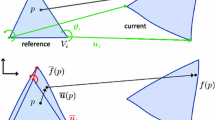Abstract
The inverse problem of reconstructing an inhomogeneous, circular, cylindrical shell, from the knowledge of scattering data, is of importance in diverse fields, including the imaging of thin veins and arteries in medicine, of co-axial cables in non-destructive testing, and of volcanic pipes in volcanology. Optical fibres provide another important example of shells evaluated by such non-invasive means.
In as much as the problem has such diverse applications, it will be useful to have an algorithm for this purpose, which (i) is computationally efficient; (ii) provides good reconstructions when the data is corrupted with additive noise which is often assumed to be Gaussian; (iii) does not employ a small-perturbations approximation, such as Born’s or Rytov’s, which restricts their scope of application.
One such algorithm is proposed in this paper. Here, computational efficiency is achieved by recognising that the circular geometry of the problem translates itself into circulant matrices that are easily inverted by invoking the Fast Fourier Transform (FFT); while the desensitization of the method to corrupting noise is carried out by employing the least-squares method.
Illustrative computer simulations verify the validity of the technique proposed.
Similar content being viewed by others
References
Boerner W M, Vandenburg F H, Hamid M A K 1971 Determination of the electrical radius ka of a circular cylindrical scatterer from the scattered field.Can. J. Phys. 49: 804–819
Cavicchi T J, Johnson S A, O’Brien W D Jr 1988 Applications of the sinc basis moment method to the reconstruction of infinite cylinders.IEEE Trans. Ultrason., Ferroelectr. Frequency Control 35: 22–33
Datta A K, Som C 1981 On the inverse scattering problem for dielectrical cylindrical scatterers.IEEE Trans. Antennas Propag. AP-29: 392–97
Devaney A J 1979 The inverse problem for random sources.J. Math. Phys. 20: 1687–91
Duchene B, Tabara W 1983a A geometrical optics method for assessing an inverse scattering problem for blood vessels — part I: A multistatic single frequency approach.IEEE Trans. Sonics Ultrason. 30: 13–19
Duchene B, Tabara W 1983b A geometrical optics method for assessing an inverse scattering problem for blood vessels — part 2: A monostatic multifrequency approach.IEEE Trans. Sonics Ultrason. 30: 20–26
Haykin S (ed.) 1985Array signal processing (Englewood Cliffs, NJ: Prentice Hall) Chap. 6
Holoubek J 1976 Light scattering from unclad fibres: approximated ray theory of back-scattered light.Appl. Opt. 15: 2751–55
Jegannathan S, Ramamurthi B 1990a Scattering from a circular dielectric cylindrical shell — a fast algorithm.Electron. Lett. 27: 484–85
Jegannathan S, Ramamurthi B 1990b Diffraction tomography of strongly-scattering infinite cylindrical objects of arbitrary cross-sectional shape,J. Acoust. Soc. Am. 88: 2713–2719
Johnson S A, Zhou Y, Tracey M K, Berggren M J, Stenger F 1984 Inverse scattering solutions by a sinc basis multiple source moment method — part 3.Ultrason. Imaging 6: 103–116
Kagami S, Fukai I 1984 Application of boundary-element method to electromagnetic field problems.IEEE Trans. Microwave Theory Tech. 32: 455–461
Kay S M 1988Modern spectral estimation: Signal Processing Series (Englewood Cliffs, NJ: Prentice Hall) Chap 1
Marcuse D 1975 Light scattering from unclad fibres: ray theory.Appl. Opt. 14: 1528–32
Nashed M Z (ed.) 1976Generalized inverse and applications (New York: Academic Press)
Oppenheim A V, Schafer R W 1988Digital signal processing (New Delhi: Prentice Hall of India) chap. 3
Presby H M, Marcuse D 1974 Refractive index and diameter determinations of step-index optical fibres.Appl. Opt. 13: 2882–85
Richmond J H 1965 Scattering by a dielectric cylinder of arbitrary cross-section shape.IEEE Trans. Antennas Propag. 13: 334–341
Schueler C F, Lee H, Wade G 1984 Fundamentals of digital ultrasonic imagingIEEE Trans. Sonics Ultrason. SU-31: 195–216
Smith P R 1987 Exact solution of the inverse acoustic scattering problem for the one-dimensional density profile in cylindrical geometry.Ultrasonics 25: 138–140
Sarkar T K, Weiner D D, Jain V K 1981 Some mathematical considerations in dealing with the inverse problem.IEEE Trans. Antennas Propag. AP-29(2): 373–378
Tracey M L, Johnson S A 1983a Inverse scattering solutions by a sinc basis, multiple source moment method — part I,Ultrason. Imaging 5: 361–375
Tracey M L, Johnson S A 1983b Inverse scattering solutions by a sinc basis, multiple source moment method — part 2.Ultrason. Imaging 5: 376–393
Watkins L S 1974 Scattering from side-illuminated clad glass fibres for determination of fibre parameters.J. Opt. Soc. Am. 64: 767–772
Wilkinson J H 1971 Modern error analysis.SIAM Rev. 13: 548–568
Wilkinson J H 1983The algebraic eigenvalue problem (Oxford: Clarendon Press)
Author information
Authors and Affiliations
Rights and permissions
About this article
Cite this article
Jegannathan, S., Ramamurthi, B. An FFT-based algorithm for reconstructing inhomogeneous circular cylindrical shells from noisy data. Sadhana 15, 235–247 (1990). https://doi.org/10.1007/BF02812039
Issue Date:
DOI: https://doi.org/10.1007/BF02812039




